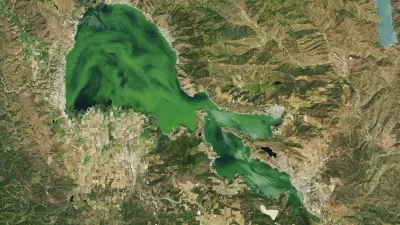Scientists hope to use AI and machine learning models to forecast water quality issues caused by toxic blue-green algae blooms.

According to the Los Alamos Reporter, scientists from the Los Alamos National Laboratory plan to use artificial intelligence modeling to forecast toxic algal blooms, which “[f]ueled by climate change and rising water temperatures … have grown in intensity and frequency” and “have now been reported in all 50 U.S. states.” Perhaps the most well-known occurrence of these harmful algal blooms, or HABs, happened in 2014, when dangerous toxin levels in Lake Erie forced Toledo, Ohio, to shut down the drinking water supply of a half-million residents for three days. Just last month, Clear Lake in California was in the news for its own blue-green algal bloom, which some fear will impact summer tourism activities.
“For decades, scientists have understood that elevated water temperatures, combined with sudden infusions of nutrients (often phosphorous and nitrogen runoff from industrial farming), tend to precede a HAB event …. But what causes toxic cyanobacteria to prevail in these freshwater ecosystems has proved challenging to understand” because they are “complex ecosystems influenced by hundreds — sometimes thousands — of other microorganisms,” the Los Alamos Reporter article reads. Armed with masses of data on HABs collected since 1954 by a variety of organizations across the nation and the world, the scientists plan to feed existing yet disparate information into a data learning model and use AI to decipher and analyze it.
“Such a model could then be used to forecast algal blooms, and possibly even predict how climate change will alter their intensity and frequency in the future,” said Babetta Marrone, senior scientist at the LANL and the project’s team lead, in a press release.
FULL STORY: LANL: AI Can Help Forecast Toxic ‘Blue-Green Tides’

Alabama: Trump Terminates Settlements for Black Communities Harmed By Raw Sewage
Trump deemed the landmark civil rights agreement “illegal DEI and environmental justice policy.”

Planetizen Federal Action Tracker
A weekly monitor of how Trump’s orders and actions are impacting planners and planning in America.

Why Should We Subsidize Public Transportation?
Many public transit agencies face financial stress due to rising costs, declining fare revenue, and declining subsidies. Transit advocates must provide a strong business case for increasing public transit funding.

Understanding Road Diets
An explainer from Momentum highlights the advantages of reducing vehicle lanes in favor of more bike, transit, and pedestrian infrastructure.

New California Law Regulates Warehouse Pollution
A new law tightens building and emissions regulations for large distribution warehouses to mitigate air pollution and traffic in surrounding communities.

Phoenix Announces Opening Date for Light Rail Extension
The South Central extension will connect South Phoenix to downtown and other major hubs starting on June 7.
Urban Design for Planners 1: Software Tools
This six-course series explores essential urban design concepts using open source software and equips planners with the tools they need to participate fully in the urban design process.
Planning for Universal Design
Learn the tools for implementing Universal Design in planning regulations.
Caltrans
Smith Gee Studio
Institute for Housing and Urban Development Studies (IHS)
City of Grandview
Harvard GSD Executive Education
Toledo-Lucas County Plan Commissions
Salt Lake City
NYU Wagner Graduate School of Public Service





























